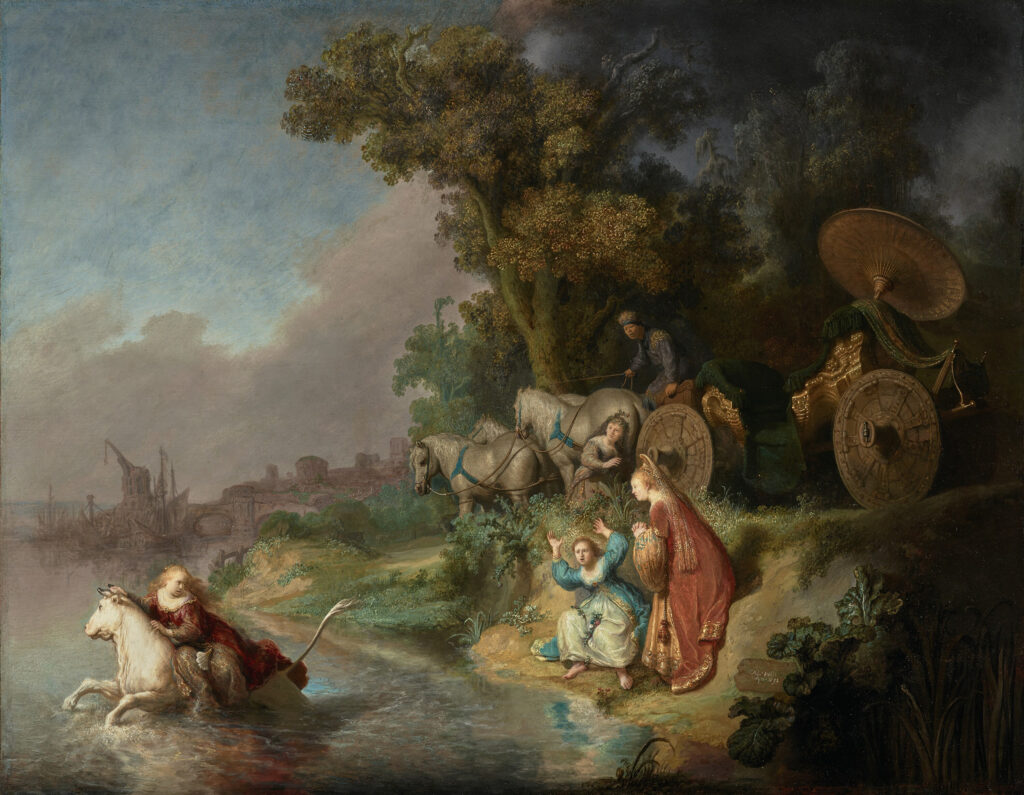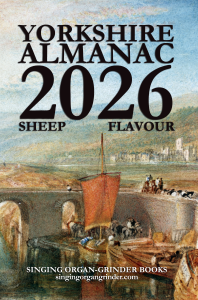23 February 1832: The son of the landlord of the Five Lions Inn, Walmgate, York is carried across the River Foss by a runaway Galloway pony

The animal was probably a brown pony, and Master Dunning was male, but here’s Rembrandt’s Zeus as a white bull, bearing the abducted Phoenician princess Europa across the Mediterranean to Crete (Rembrandt 1632).
Dublin Observer contributor. 1832/02/26. [An Errant Bovid]. Dublin observer. Dublin. Get it:
.Excerpt
A Scotch Galloway was taken into the yard of Mr. Dunning, of the Five Lions Inn, Walmgate, on Thursday afternoon, which his son mounted, and the animal set off at full speed towards the bottom of the yard, which is terminated by a passage and several steps, leading to the River Foss. The animal leaped down there, the boy keeping his seat, and they were both plunged to the bottom of the river. On rising to the surface, the animal swam to the opposite side, and the boy and Galloway were landed in safety, without either having sustained any injury.
Comment
Comment
Via John Bibby (Bibby 2022). Unfortunately no contemporary York versifiers seem to have been inspired by the incident. Having only met bovine Galloways I originally thought this was a cow, but the beast is surely equine. A contemporary expert says the term by then indicated size and character rather than breed:
A horse between thirteen and fourteen hands in height is called a GALLOWAY, from a beautiful breed of little horses once found in the south of Scotland, on the shore of the Solway Firth, but now sadly degenerated, and almost lost, from the attempts of the farmers to obtain a larger kind, and better adapted for the purposes of agriculture. There is a tradition in that country, that the breed is of Spanish extraction, some horses having escaped from one of the vessels of the Grand Armada, which was wrecked on the neighbouring coast. This district, however, so early as the time of Edward I., supplied that monarch with a great number of horses.
The pure galloway was said to be nearly fourteen hands high, and sometimes more; of a bright bay, or brown, with black legs, small head and neck, and peculiarly deep and clean legs. Its qualities were speed, stoutness, and sure-footedness over a very rugged and mountainous country.
Dr. Anderson thus describes the galloway: “There was once a breed of small elegant horses in Scotland, similar to those of Iceland and Sweden, and which were known by the name of galloways; the best of which sometimes reached the height of fourteen hands and a half. One of this description I possessed, it having been bought for my use when a Ι boy. In point of elegance of shape it was a perfect picture; and in disposition was gentle and compliant. It moved almost with a wish, and never tired. I rode this little creature for twenty-five years, and, twice in that time I rode a hundred and fifty miles at a stretch, without stopping, except to bait, and that not for above an hour at a time. It came in at the last stage with as much ease and alacrity as it travelled the first. I could have undertaken to have performed on this beast, when it was in its prime, sixty miles a-day for a twelvemonth running without any extraordinary exertion.”
[…]
Many of the galloways now in use are procured either from Wales or the New Forest, but they have materially diminished in number : there are scarcely sufficient to supply even the neighbouring districts, and they are still more materially deteriorated in form and value. Both the Welsh and the Hampshire galloways and ponies claim, however, some noble blood.
(Youatt 1831)
Something to say? Get in touch
Original
A Scotch Galloway was taken into the yard of Mr. Dunning, of the Five Lions Inn, Walmgate, on Thursday afternoon, which his son mounted, and the animal set off at full speed towards the bottom of the yard, which is terminated by a passage and several steps, leading to the River Foss. The animal leaped down there, the boy keeping his seat, and they were both plunged to the bottom of the river. On rising to the surface, the animal swam to the opposite side, and the boy and Galloway were landed in safety, without either having sustained any injury.
102 words.
Similar
 2 July 1644: Henry Slingsby of the Royalist York garrison recounts Prince Rupert’s defeat at Marston Moor today, which ends Charles I’s hopes in the north
2 July 1644: Henry Slingsby of the Royalist York garrison recounts Prince Rupert’s defeat at Marston Moor today, which ends Charles I’s hopes in the north 3 January 1638: On the eve of the civil war, Henry Slingsby witnesses Royalist cavalry exercising near Wetherby on Bramham Moor, scene of the defeat of the Percy Rebellion in 1408
3 January 1638: On the eve of the civil war, Henry Slingsby witnesses Royalist cavalry exercising near Wetherby on Bramham Moor, scene of the defeat of the Percy Rebellion in 1408 25 September 1066: The Stamford Bridge massacre by Harold Godwinson’s army of Harald Hardrada and Tostig Godwinson’s force – symbol of the end of the Viking Age
25 September 1066: The Stamford Bridge massacre by Harold Godwinson’s army of Harald Hardrada and Tostig Godwinson’s force – symbol of the end of the Viking AgeSearch
Donate
Music & books
Place-People-Play: Childcare (and the Kazookestra) on the Headingley/Weetwood borders next to Meanwood Park.
Music from and about Yorkshire by Leeds's Singing Organ-Grinder.


 Bluesky
Bluesky Extwitter
Extwitter